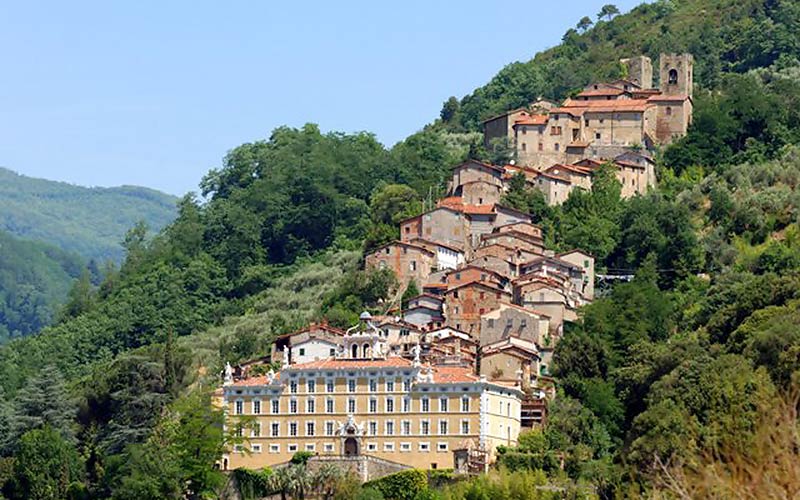Visiting Valdinievole’s hamlets and villages
Give yourselves the joy of an authentic experience, discover the Valdinievole, an area rich in history, culture and tradition.
An area of a thousand different aspects, reinvigorating like the water of its famous springs, unpolluted like its luxuriant nature, genuine as its cooking, intriguing as the world’s most famous puppet and inspired like the celebrities who have loved it.
The Vallis Nebulae, the fog-filled valley, in the very heart of Tuscany, nestles in the gently sloping hills which lie between Pistoia and Lucca. You will be surprised by the beauty of hidden gems, found in a little museum or in a country parish church, to be reached on foot along paths winding through olive groves.
Enjoy the cobbled alleys in small hamlets, lying between flowering gardens and majestic villas, and reach the peak dominating the whole valley. The citadels and the towers of its original castles will evoke memories of their history, made up of battles between the cities of Pistoia, Lucca and Florence, of high class craftsmanship and of thriving trade.
The Valdinievole will amaze you with the authenticity of its hamlets and the true beauty of the nature surrounding them.
Close to Florence, Pisa and Lucca, the Valdinievole is the ideal place from where to start to look for hidden treasures, romantic nooks and crannies and genuine gems which time has conserved intact, so that you will be able to embrace that wonderful splendour which makes our country the most beautiful place in the world.
Montecatini Alto, near the thermal town of the same name, is a small and charming village with cobbled streets, a medieval fortress, the ‘Palazzo del Podestà’ and the piazzetta Giusti where you can stop to taste some delicious specialities. If you take the funicular railway to get there, it will make your journey even more delightful.
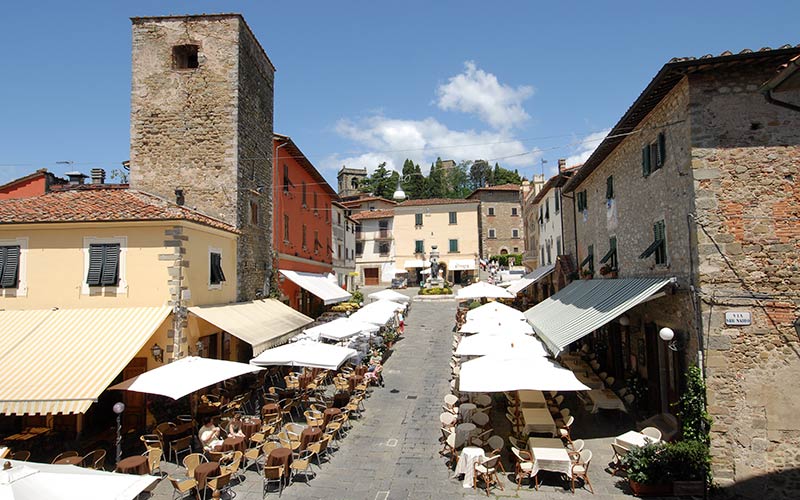
Montecatini Alto
One of the most loved villages of this area is Montecatini Alto, an ideal place for relaxation, thanks to all that takes place in its ‘salon’, Piazza Giusti, and to its wonderful sunsets with panoramic views over the valley. This hamlet has two ‘hearts’: its medieval one with its ‘Palazzo del Podestà’ and Ugolino Caccini’s tower; and its Art Nouveau one with its ‘Teatro dei Risorti’.
This is the beginning of a fascinating journey on the lookout for small and ancient hamlets, each of them with a tale to be told. By car, by bike or on foot, along numerous paths and trails…..any way is the right way to explore the Valdinievole.
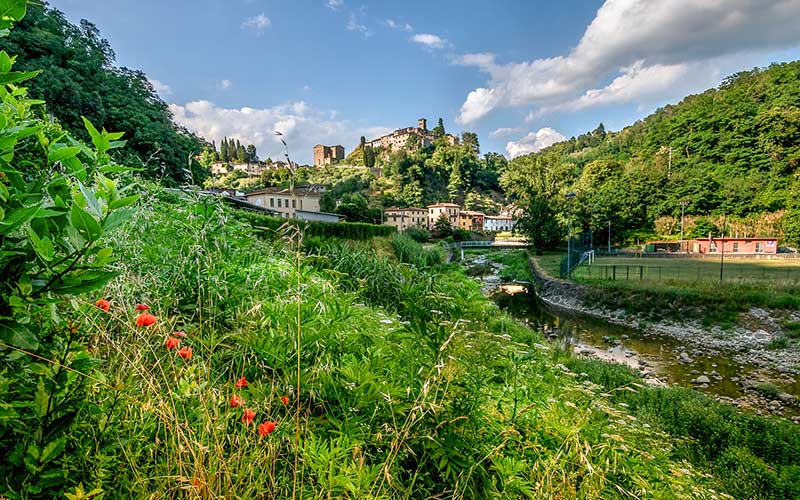
Find the time to visit – but not in a hurry – the area around Pescia, a unique and fascinating place, worthy of its name “the Swiss Pesciatina”, as it is known locally. Gently sloping hills and small villages, a picture postcard countryside, authentic as the ten medieval Castella (country villages) which, one after the other, will appear before your eyes.
The small and fortified hamlet of Massa is well worth a visit – once surrounded by its own walls of which only a few parts remain today – with its towers and imposing gates; as is Cozzile, too, with its narrow alleys, its ‘piazzetta’, the majestic Palazzo De Gubernatis and its picturesque areas. If you go along the steep little road between olive groves, right up to the 19th century ‘palazzo’, you will find yourself in the midst of total silence surrounded by the peacefulness of nature.
It is also well worth going to the medieval hamlet of Uzzano Castello, an antique little centre where pilgrims and wayfarers once used to pass through; it stands on top of a hill from where you can see all the Valdinievole area. A romantic place, especially at night, thanks to the way it is lit and illuminated which makes it recognizable from anywhere down in the valley.
In spring, treat yourself to an intoxicating walk through the lanes of Buggiano Castello, known as the citrus hamlet, due to its abundance of splendid, private gardens, and go on to reach the panoramic terrace from where – on a clear day – you can even catch sight of San Gimignano and Volterra. A short distance away, in a countryside rich in olives, you can find the picturesque hamlet of Colle di Buggiano.
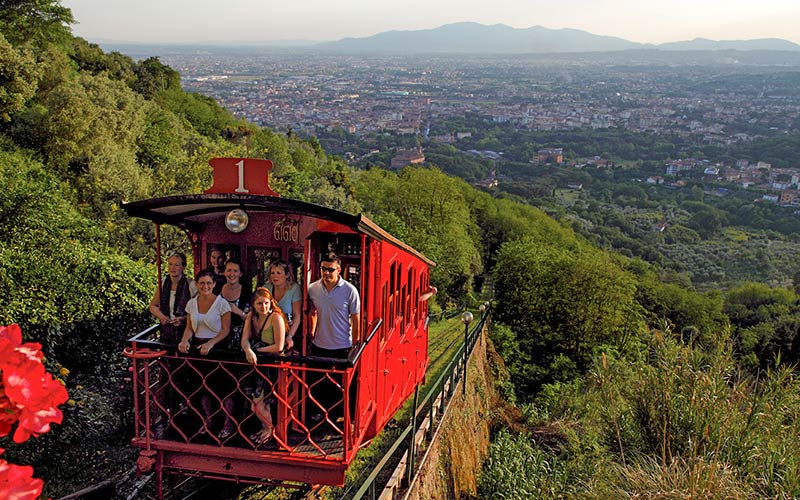
La Funicolare
On 4th June 1898, in the presence of Giuseppe Verdi and other important guests, the funicular running between “Bagni di Montecatini” and “Castello” was inaugurated. Along 1077 metres, Gigio and Gigia – the names of the two historic, red cable cars, restored and still in use – take 8 minutes and 30 seconds to complete their journey.
The ‘Road of Olive Oil of the Hamlets and Castles of Valdinievole‘ passes through the villages of Uzzano, Buggiano and Massa e Cozzile, in an area rich in olive groves; along this road, you can stop to taste olive oil and other typical local products, in farms, holiday farms and restaurants which you will come across along the way.
A few miles away from Monsummano Terme, stands Monsummano Alto which will take you back in time with its impressive remains of ancient strongholds and its old lookout tower: you must be sure to climb up to its very top so that you can enjoy a breathtaking and panoramic view over all the surrounding countryside.
Don’t forget to stop at Montevettolini, a tiny hamlet, originally an ancient medieval fortress, much loved by the Medici family who built a splendid villa there.
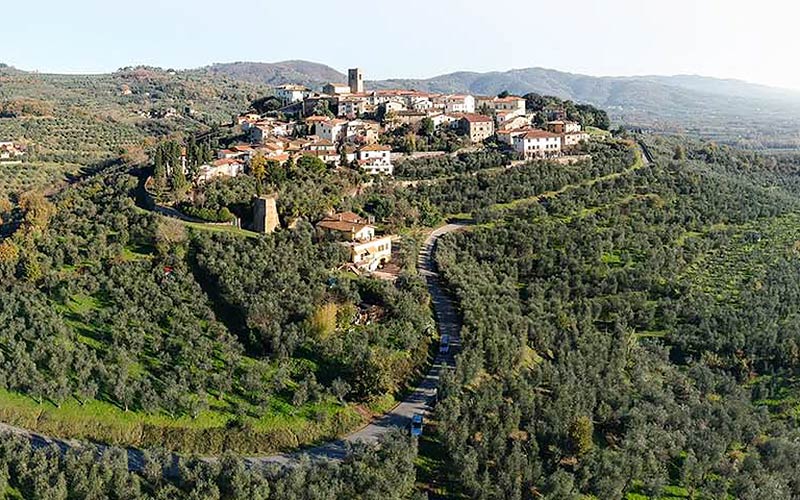
Leonardo at Montevettolini
Many art historians and academics have speculated about the possibility that Leonardo da Vinci’s painting, of 1473, depicting the countryside around the lower stretch of the River Arno would have had as his point of reference the hamlet of Montevettolini from where, still today, you can enjoy a spectacular vista over all the valley.
On the slopes of Montalbano, near Larciano, two villages are well worth visiting: Cecina, a medieval hamlet, probably of Etruscan origin, with its ring of stone walls and its ancient entrance gates; and Larciano Castello with its typically medieval features, surrounded by a 13th century ring of walls. By going through one of its three, still visible gates, you can reach its highest spot where a fortress towers above the village, and from where you can admire a wonderful panoramic view over the Valdinievole.
